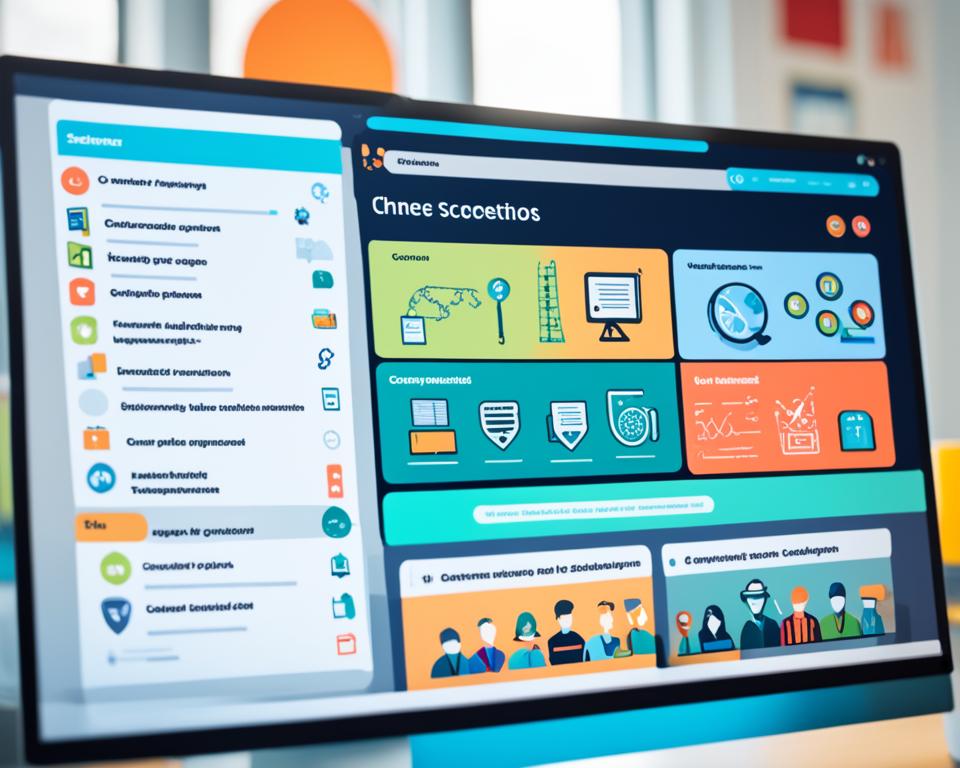In today’s digital age, institutions are increasingly turning to online programs as a means to reach a wider audience and provide flexible learning options. However, with the growing competition in the online education space, it is crucial for institutions to effectively promote their programs and attract students. By implementing proven digital marketing strategies, institutions can increase enrollment and enhance their online visibility, ultimately achieving success in the virtual classroom.
Online program promotion requires a comprehensive approach that encompasses various tactics such as student recruitment, effective online marketing, and targeted advertising. Institutions need to leverage the power of digital platforms to engage with potential students and showcase the unique benefits of their programs.
Key Takeaways:
- Promoting online programs requires effective digital marketing strategies
- Institutions should leverage social media to engage with potential students
- Crafting compelling course descriptions that target the interests and aspirations of the audience is crucial
- Pricing strategies, social proof, and affiliate marketing can all play a role in attracting students
- Creating informative content and utilizing landing pages are effective tactics for enrollment
Leveraging Social Media to Attract Students
Institutions looking to attract students to their online programs must establish a strong online presence through social media marketing. By leveraging popular social platforms and implementing effective strategies, institutions can engage with potential students, promote their offerings, and increase enrollment.
To effectively leverage social media for student attraction, institutions should:
- Create profiles on key social platforms
- Post engaging content tailored to the interests of potential students
- Engage actively in conversations with followers
- Maintain a consistent posting schedule
- Utilize social media ads to target a specific audience
A well-executed social media marketing strategy can significantly enhance an institution’s online presence and attract a larger number of students. By showcasing the value of their online programs and interacting with potential students, institutions can foster a sense of community and establish themselves as trusted educational providers.
“Social media provides a unique opportunity for institutions to connect with their target audience on a more personal level. By creating valuable and engaging content, institutions can build relationships, address concerns, and showcase their expertise.”
Table: Comparison of social media platforms for student attraction:
| Social Media Platform | Advantages | Disadvantages |
|---|---|---|
| Large user base, diverse targeting options | High competition for ad space | |
| Visual appeal, strong engagement | Requires visually appealing content | |
| Professional network, targeting professionals and jobseekers | Higher cost per click | |
| Real-time engagement, trending topics | Limit on character count |
It is essential for institutions to understand the strengths and weaknesses of different social media platforms and select those most aligned with their target audience. By crafting compelling content, engaging with followers, and utilizing social media ads strategically, institutions can enhance their online visibility and attract students to their online programs.
Crafting Irresistible Course Descriptions
To attract students to online programs, institutions must create compelling course descriptions that effectively communicate the unique benefits and appeal to the target audience. Clear and engaging language, avoiding jargon, is key to ensuring clarity and avoiding alienation, especially among beginners. Including practical details such as duration, structure, and prerequisites can further enhance the description’s appeal and provide valuable information for potential students.
Course descriptions should be crafted with a specific target audience in mind, addressing their aspirations, interests, and goals. By understanding the needs and desires of the target audience, institutions can tailor the descriptions to resonate with them on a personal level, making the online programs more appealing.
“Crafting course descriptions that speak to the potential student’s aspirations and goals is crucial for attracting their interest and engagement.”
| Components of an Effective Course Description | Examples |
|---|---|
| Unique Benefits: | “Develop cutting-edge coding skills to drive innovation in the tech industry.” |
| Clarity: | “Learn advanced marketing strategies through real-world case studies and hands-on projects.” |
| Call to Action: | “Enroll now and take the next step towards a rewarding career in healthcare.” |
In addition to highlighting the unique benefits, a course description should have a strong call to action at the end, encouraging potential students to take the next step, whether it’s enrolling in the program, requesting more information, or exploring other related courses. This call to action should be compelling and persuasive, instilling a sense of urgency and excitement.
By crafting irresistible course descriptions that effectively communicate the unique benefits, appeal to the target audience, and include a compelling call to action, institutions can significantly increase the chances of attracting and converting potential students into enrolled learners.

Pricing Strategies to Attract Students
Pricing plays a critical role in attracting students to online programs. Institutions can implement various pricing strategies to entice potential learners and increase enrollment. By considering tiered pricing options, offering discounts and promotions, providing a money-back guarantee, and assessing customer lifetime value, institutions can successfully attract students and create a competitive advantage in the online education market.
Tiered Pricing Options
One effective pricing strategy is to offer tiered pricing options to cater to different budgets and needs. By providing multiple pricing tiers, institutions can accommodate students with varying financial means and ensure that their online programs are accessible to a wider audience.
Discounts and Promotions
Discounts and promotions can create a sense of urgency and incentivize potential students to enroll in online programs. Institutions can offer limited-time discounts during launch periods, holidays, or other special occasions to encourage immediate enrollment. These promotions not only attract students but also convey the idea that the institution values affordability and accessibility.
Money-Back Guarantee
Offering a money-back guarantee is an effective way to alleviate concerns and build trust with potential students. By assuring students that they can receive a refund if they are not satisfied with the program, institutions can mitigate the perceived risk of enrollment. This guarantee demonstrates the institution’s commitment to student success and satisfaction.
Assessing Customer Lifetime Value
When setting the price for their online programs, institutions should consider the customer lifetime value (CLV). CLV refers to the projected revenue that a student will generate throughout their engagement with the institution. By understanding the long-term value of each student, institutions can set prices that align with their financial goals while also providing value to the students.
In conclusion, implementing effective pricing strategies is essential for attracting students. Tiered pricing options, discounts and promotions, money-back guarantees, and considering customer lifetime value can help institutions increase enrollment and establish a competitive edge in the online education landscape.
Harnessing the Power of Social Proof
When it comes to attracting students to online programs, social proof is an invaluable asset. By showcasing testimonials from past students and their success stories, institutions can build credibility and inspire confidence in potential learners. Additionally, ratings and reviews serve as powerful indicators of the quality of an online program, further attracting students. To maximize the impact of social proof, institutions can leverage various social proof tools.
Testimonials and Success Stories
Testimonials and success stories provide tangible evidence of the value and impact of online programs. Past students who have experienced positive outcomes can offer firsthand accounts of their journey, encouraging potential learners to embark on a similar path. By gathering testimonials and showcasing success stories on their website or course platform, institutions can effectively demonstrate the benefits and potential of their online programs.
“Thanks to the online program at ABC University, I was able to acquire the skills and knowledge needed to make a successful career switch to the tech industry. The curriculum was comprehensive, and the support from the faculty was outstanding. I am now thriving in my new role, all thanks to the quality education I received.”
– Jane Smith, Graduate of ABC University’s Online Program
Ratings and Reviews
Ratings and reviews play a vital role in influencing the decision-making process of potential students. Positive ratings and glowing reviews can significantly enhance an institution’s credibility and attract more learners. By encouraging students to leave feedback on course platforms or websites, institutions can create a dynamic and trustworthy online community.
Utilizing Social Proof Tools
Social proof tools such as Easy Video Reviews and TrustPulse can further amplify the impact of testimonials, success stories, and ratings. These tools provide platforms for institutions to gather, manage, and display social proof elements effectively. With features like video testimonials and real-time notifications, these tools enhance the persuasive power of social proof, making it more visually appealing and engaging for potential students.
Incorporating social proof tools into an institution’s online presence can create a sense of trust and legitimacy, helping to attract a larger audience and convert visitors into enrolled students.
Real-Time Social Proof Example
| Online Program | Average Rating | Number of Reviews |
|---|---|---|
| ABC University Online Program | 4.8 | 156 |
| XYZ College Online Program | 4.5 | 82 |
| 123 Academy Online Program | 4.9 | 234 |
Based on the real-time data displayed above, it is evident that the ABC University Online Program has garnered the highest average rating and the highest number of reviews, indicating a high level of student satisfaction. This social proof can greatly influence the decision-making process of potential students, making them more likely to choose ABC University for their online education needs.
By harnessing the power of social proof through testimonials, success stories, ratings, and reviews, institutions can establish trust, credibility, and authenticity. Incorporating social proof tools further enhances and streamlines the process, maximizing the impact on potential students. Through the effective utilization of social proof, institutions can attract a larger number of students to their online programs.
Implementing Affiliate Marketing for Student Recruitment
Affiliate marketing can be a powerful strategy for institutions to recruit new students into their online programs. By leveraging the network of current students, influencers, and individuals, institutions can tap into an extensive pool of potential learners. Implementing a referral program combined with incentives and collaborations can significantly boost student enrollment.
MemberPress is an excellent tool that simplifies the process of setting up a referral program and managing affiliate marketing. It provides institutions with the necessary features and functionalities to track referrals, manage commissions, and monitor the performance of their affiliates.
Benefits of Affiliate Marketing for Student Recruitment
- Increased Reach: Affiliates, such as student ambassadors and influencers, have their own networks and platforms, allowing institutions to reach a wider audience.
- Social Proof: Collaborating with influencers who have established credibility in the industry enhances the perception of the institution and its online programs.
- Flat Fee for New Sign-ups: Institutions can offer a flat fee for every new student referred, making the program more enticing and encouraging increased enrollment.
- Cost-Effective: Institutions only pay Affiliate commissions when they successfully refer new students, providing a cost-effective method of student recruitment.
“Affiliate marketing allows institutions to tap into the power of word-of-mouth marketing and leverage the influence of their existing students and influencers, ultimately attracting more students to their online programs.”
Implementing an affiliate marketing strategy requires careful planning and execution. Institutions must establish clear guidelines, set commission rates, and provide affiliates with the necessary promotional materials. Regular monitoring and communication with affiliates are essential to ensure the success of the program.
Creating Informative Content to Attract Students
Institutions can effectively attract students by creating valuable and informative content. By offering free samples of course material, institutions can give potential students a taste of what to expect and pique their interest. Additionally, creating educational pieces such as infographics or guides that showcase the value of the courses can capture the attention of prospective students.
These materials should be made readily available on the institution’s website, blog, social media platforms, and through email marketing campaigns. By providing valuable content, institutions can establish themselves as credible sources of information and build trust with their target audience.
Free Samples
Offering free samples of course material is a great way to showcase the quality and relevance of the online programs. By allowing potential students to access a portion of the course content for free, they can get a firsthand experience of the teaching style, course structure, and the value they can gain from enrolling.
For example, an online university offering a course in digital marketing could provide a free module or introductory lesson that covers fundamental concepts. This allows potential students to gauge their interest and determine if the course aligns with their learning goals.
Educational Pieces
Institutions should also create educational pieces such as infographics or guides that highlight the unique benefits and key features of their online programs. These materials can explain complex concepts in a visually engaging and easily understandable format.
For instance, a graphic design program could create an infographic showcasing the different career paths available, salary projections, and the industry’s demand for skilled professionals. This type of content can help prospective students understand the practical value of the program and make informed decisions about their educational pursuits.
The Power of Informative Content
“By providing valuable and informative content, institutions can demonstrate their expertise, establish credibility, and attract students who are actively seeking knowledge and skills. By addressing the pain points and aspirations of prospective students through educational materials, institutions can make a compelling case for enrolling in their online programs.”
Benefits of Informative Content
| Benefits | Description |
|---|---|
| Establishes credibility | Informative content positions institutions as experts in their field and builds trust with potential students. |
| Attracts an engaged audience | By addressing the pain points and aspirations of prospective students, informative content attracts individuals who are actively seeking education and career development opportunities. |
| Drives organic traffic | Well-optimized informative content can increase organic search visibility and drive qualified traffic to the institution’s website, ultimately leading to higher conversion rates. |
| Encourages social sharing | Compelling and insightful content is more likely to be shared on social media platforms, increasing brand awareness and potentially reaching a wider audience. |
By creating informative content such as free samples, educational pieces, infographics, and guides, institutions can effectively attract students to their online programs. This approach not only helps potential students make informed decisions but also establishes the institution as a reliable and trustworthy educational provider.

Utilizing Landing Pages for Enrollment
Landing pages play a crucial role in attracting and enrolling students in online programs. These web pages act as showcases, effectively communicating the value and benefits of the programs to potential students. By implementing a well-designed landing page with a clear call to action, institutions can significantly increase enrollment rates. In this section, we will explore how landing pages can be optimized to convert potential students into enrolled individuals.
The Importance of Landing Pages
Landing pages serve as the first point of contact for potential students interested in online programs. They provide a focused and persuasive presentation of the institution’s offerings, ensuring that visitors understand the benefits and features of the programs. A well-designed landing page can make a lasting impression and influence the decision-making process.
Showcasing the Benefits
When creating landing pages, institutions should emphasize the unique benefits that their online programs offer. Highlighting these advantages helps potential students understand why they should choose a particular program and what sets it apart from others. Whether it’s flexible scheduling, industry-recognized certifications, or personalized support, showcasing the benefits can be a compelling way to attract and engage students.
Call to Action
A clear and strategic call to action is an essential component of an effective landing page. Institutions should guide potential students toward the enrollment process by using persuasive language and prominent buttons or links. The call to action should communicate a sense of urgency, whether it’s encouraging them to apply, enroll, or start their learning journey right away.
Explanatory Videos
Including explanatory videos on landing pages can be a powerful tool to engage potential students. These videos can address common questions, provide an overview of the program’s curriculum, or feature testimonials from current students. Adding visual content helps create a stronger connection with the audience and enhances their understanding of the program’s value.
“A well-designed landing page can effectively convert potential students into enrolled individuals. By showcasing the benefits, including a clear call to action, and incorporating explanatory videos, institutions can create a compelling user experience that leads to higher enrollment rates.”
Promoting Online Education through Specialized Platforms
In addition to the various strategies mentioned, institutions can effectively promote their online programs by selling content through specialized platforms. These platforms offer a convenient and efficient way for institutions to reach a wider audience and increase their online visibility. By leveraging specialized platforms, institutions can save time on promotion efforts and attract more students to their online programs.
Specialized platforms provide a dedicated space for institutions to showcase their online courses, ensuring that they can be easily discovered by individuals interested in a particular subject or field. These platforms often have a large user base, allowing institutions to tap into an existing community of learners. By listing their programs on specialized platforms, institutions can expand their reach and connect with a broader audience of potential students.
Benefits of Selling Content through Specialized Platforms
There are several benefits to selling content through specialized platforms:
- Increased Exposure: By listing their online programs on specialized platforms, institutions can gain additional exposure and visibility. These platforms often have a large following of targeted users who are actively seeking educational opportunities.
- Access to a Wider Audience: Specialized platforms attract learners from diverse backgrounds and geographical locations. This provides institutions with an opportunity to reach a wider audience and attract students who may not have otherwise discovered their programs.
- Elevated Credibility: Listing online programs on reputable specialized platforms enhances the credibility and reputation of institutions. Learners perceive these platforms as trusted sources of high-quality educational content, which can encourage them to enroll in the offered programs.
- Time-Saving: Instead of relying solely on their own marketing efforts, institutions can leverage the marketing reach of specialized platforms. This allows institutions to save time on promotional activities and focus more on creating and delivering exceptional online programs.
- Easy Integration: Many specialized platforms provide seamless integration options, enabling institutions to effortlessly connect their existing learning management systems or online course platforms. This simplifies the process of uploading and managing course content, ensuring a seamless user experience for students.
Overall, selling content through specialized platforms offers institutions a valuable opportunity to promote their online programs and attract a wider audience of students. The convenience, wider reach, and time-saving nature of these platforms make them an effective addition to any institution’s marketing strategy in the digital learning environment.
| Benefits of Selling Content through Specialized Platforms |
|---|
| Increased Exposure |
| Access to a Wider Audience |
| Elevated Credibility |
| Time-Saving |
| Easy Integration |

Conclusion
By implementing the strategies mentioned in this article, institutions can effectively promote their online programs and attract a larger number of students. Leveraging social media is a powerful way to enhance their online visibility. Creating engaging and irresistible course descriptions that speak directly to the target audience’s aspirations is key. Implementing pricing strategies, such as tiered pricing options and discounts, can also attract students by catering to different budgets and creating a sense of urgency. Additionally, harnessing the power of social proof, through testimonials and ratings, can boost credibility and attract more students.
Affiliate marketing is another effective strategy for student recruitment, with incentives for referrals from current students and collaborations with influencers. Creating valuable and informative content, such as free samples and educational materials, can capture the interest of potential students and demonstrate the value of the online programs. Utilizing well-designed landing pages with clear calls to action and explanatory videos can convert potential students into enrolled individuals. Lastly, promoting through specialized platforms can provide wider reach and save time on promotion efforts.
By continuously improving these strategies and adapting to the evolving online education landscape, institutions can successfully attract students and thrive in the digital learning environment.
FAQ
How can institutions promote online programs and attract students?
Institutions can promote online programs and attract students by implementing effective digital marketing strategies. This can include leveraging social media, crafting compelling course descriptions, implementing pricing strategies, harnessing the power of social proof, utilizing affiliate marketing, creating informative content, using landing pages, and promoting through specialized platforms. By following these strategies, institutions can enhance their online visibility and increase enrollment.
How can institutions leverage social media to attract students?
Institutions can establish a strong social media presence by creating profiles on key social platforms and posting engaging content that directly addresses the interests of potential students. By being active in conversations with followers and maintaining consistency in posting, institutions can effectively promote their online programs. Social media ads can also be used to target a specific audience and achieve impressive conversion rates.
How can institutions craft irresistible course descriptions?
To craft irresistible course descriptions, institutions should highlight the unique benefits of the courses and speak directly to the aspirations of the target audience. Clear and engaging language should be used, avoiding jargon that may alienate beginners. Course descriptions should include practical details such as duration, structure, and prerequisites. A strong call to action at the end of the description can encourage potential students to take the next step.
What pricing strategies can institutions implement to attract students?
Institutions can consider offering tiered pricing options to cater to different budgets and needs. Discounts and promotions, especially during launch periods or special occasions, can create a sense of urgency and encourage enrollment. Offering a money-back guarantee provides a safety net for students and boosts trust and confidence, leading to higher conversion rates. Institutions should consider the customer lifetime value when setting the price for their online programs.
How can institutions harness the power of social proof?
Institutions can gather testimonials from past students and showcase their success stories. Ratings and reviews can also boost credibility and attract more students. Utilizing social proof tools, such as Easy Video Reviews and TrustPulse, can help institutions build up their social proof. Encouraging students to leave feedback on course platforms or websites can further enhance the credibility of the programs.
How can institutions implement affiliate marketing for student recruitment?
Institutions can offer incentives to current students for referring new learners or collaborate with influencers and individuals to promote their programs. Many successful online programs offer a flat fee for new sign-ups, making the program more enticing and leading to increased enrollment. Setting up a referral program can be made easier with tools like MemberPress.
How can institutions create informative content to attract students?
Institutions can attract students by creating valuable and informative content. Offering free samples of course material can attract potential students and give them a taste of what to expect. Creating educational pieces such as infographics or guides that demonstrate the value of the courses can also capture the interest of prospective students. These materials should be made available on the institution’s website, blog, social media platforms, and via email.
How can institutions utilize landing pages for enrollment?
Landing pages are crucial for student enrollment. These web pages serve as showcases for potential subscriptions or purchases and should include a clear call to action. Institutions should emphasize the benefits of their online programs and consider including explanatory videos that answer frequently asked questions. A well-designed landing page can effectively convert potential students into enrolled individuals.
How can institutions promote online education through specialized platforms?
Institutions can promote their online programs by selling content through specialized platforms. These platforms can help institutions reach a wider audience and save time on promotion efforts. Selling content through established platforms can provide additional exposure and attract more students to the online programs offered by institutions.





